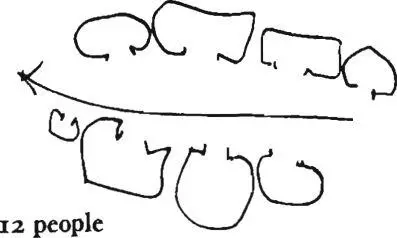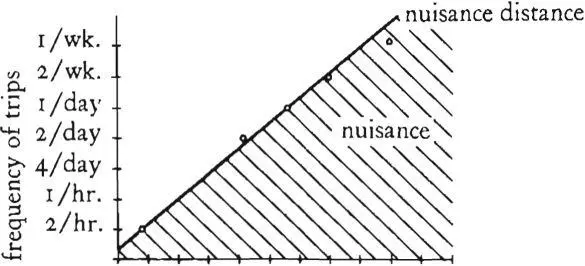Christopher alexander - A pattern language
Здесь есть возможность читать онлайн «Christopher alexander - A pattern language» весь текст электронной книги совершенно бесплатно (целиком полную версию без сокращений). В некоторых случаях можно слушать аудио, скачать через торрент в формате fb2 и присутствует краткое содержание. Жанр: Прочая научная литература, на английском языке. Описание произведения, (предисловие) а так же отзывы посетителей доступны на портале библиотеки ЛибКат.
- Название:A pattern language
- Автор:
- Жанр:
- Год:неизвестен
- ISBN:нет данных
- Рейтинг книги:3 / 5. Голосов: 1
-
Избранное:Добавить в избранное
- Отзывы:
-
Ваша оценка:
- 60
- 1
- 2
- 3
- 4
- 5
A pattern language: краткое содержание, описание и аннотация
Предлагаем к чтению аннотацию, описание, краткое содержание или предисловие (зависит от того, что написал сам автор книги «A pattern language»). Если вы не нашли необходимую информацию о книге — напишите в комментариях, мы постараемся отыскать её.
A pattern language — читать онлайн бесплатно полную книгу (весь текст) целиком
Ниже представлен текст книги, разбитый по страницам. Система сохранения места последней прочитанной страницы, позволяет с удобством читать онлайн бесплатно книгу «A pattern language», без необходимости каждый раз заново искать на чём Вы остановились. Поставьте закладку, и сможете в любой момент перейти на страницу, на которой закончили чтение.
Интервал:
Закладка:
♦J*
Departments and public services don’t work if they are too large. When they are large, their human qualities vanish; they become bureaucratic; red tape takes over.
There is a great deal of literature on the way red tape and bureaucracy work against human needs. See, for example, Gideon Sjoberg, Richard Brymer, and Buford Farris, “Bureaucracy and the Lower Class,” Sociology and Social Research, 50, April, 1966, pp. 325—77; and Alvin W. Gouldner, “Red Tape as a Social Problem,” in Robert Mertin, Reader in Bureaucracy , Free Press, 195 2, pp. 410-18.
According to these authors, red tape can be overcome in two ways. First, it can be overcome by making each service program small and autonomous. A great deal of evidence shows that red tape occurs largely as a result of impersonal relationships in large institutions. When people can no longer communicate on a face-to-face basis, they need formal regulations, and in the lower echelons of the organization, these formal regulations are followed blindly and narrowly.
Second, red tape can be overcome by changing the passive nature of the clients’ relation to service programs. There is considerable evidence to show that when clients have an active relationship with a social institution, the institution loses its power to intimidate them.
We have therefore concluded that no service should have more than 12 persons total (all staff, including clerks). We base this figure on the fact that 12 seems to be the largest number of
SNMOX
TOWNS
people that can sit down in a face-to-face discussion. It seems likely that a smaller staff size will work better still. Furthermore, each service should be relatively autonomous—subject only to a few simple, coordinative regulations from parent organizations— and that this should be emphasized by physical autonomy. In order to be physically autonomous, each service must have an area which is entirely under its own jurisdiction; with its own door on a public thoroughfare, and complete physical separation from other services.
This pattern applies equally to the departments of a city hall, a medical center, or to the local branches of a welfare agency. In most of these cases the pattern would require basic changes in administrative organization. However difficult they may be to implement, we believe these changes are required.
Therefore:
In any institution whose departments provide public service:
1. Make each service or department autonomous as far as possible.
2. Allow no one service more than 12 staff members total.
3. House each one in an identifiable piece of the building.
4. Give each one direct access to a public thoroughfare.
| visible front | |
|---|---|
 |
public thoroughfare |
406
8 l SMALL SERVICES WITHOUT RED TAPE
♦£• ♦**
Arrange these departments in space, according to the prescription of OFFICE CONNECTIONS (82) and BUILDING COMPLEX (95) ; if the public thoroughfare is indoors, make it a building thoroughfare (lOl), and make the fronts of the services visible as a family of entrances (102) ; wherever the services are in any way connected to the political life of the community, mix them with ad hoc groups created by the citizens or users— necklace of community projects (45) ; arrange the inside space of the department according to flexible office space (146); and provide rooms where people can team up in two’s and three’s—small work groups (148) . . . .
407
82 OFFICE CONNECTIONS *
. . . in any work community or any office, there are always various human groups—and it is always important to decide how these groups shall be placed, in space. Which should be near each other, which ones further apart? This pattern gives the answer to this question, and in doing so, helps greatly to construct the inner layout of a work community(41) or of self-governing WORKSHOPS AND OFFICES(80) Orof SMALL SERVICES WITHOUT RED TAPE (8l).
*$♦ ♦£*
If two parts of an office are too far apart, people will not move between them as often as they need to; and if they are more than one floor apart, there will be almost no communication between the two.
Current architectural methods often include a proximity matrix, which shows the amount of movement between different people and functions in an office or a hospital. These methods always make the tacit assumption that the functions which have the most movement between them should be closest together. However , as usually stated , this concept is completely invalid.
The concept has been created by a kind of Taylorian quest for efficiency, in which it is assumed that the less people walk about, the less of their salary is spent on “wasteful” walking. The logical conclusion of this kind of analysis is that, if it were only possible, people should not have to walk at all, and should spend the day vegetating in their armchairs.
The fact is that people work best only when they are healthy in mind and body. A person who is forced to sit all day long behind a desk, without ever stretching his legs, will become restless and unable to work, and inefficient in this way. Some walking is very good for you. It is not only good for the body, but also gives people an opportunity for a change of scene, a way
82 OFFICE CONNECTIONS
of thinking about something else, a chance to reflect on some detail of the morning’s work or one of the everyday human problems in the office.
On the other hand, if a person has to make the same trip, many times, there is a point at which the length of the trip becomes time-consuming and annoying, and then inefficient, because it makes the person irritable, and finally critical when a person starts avoiding trips because they are too long and too frequent.
An office will junction efficiently so long as the feofle who work there do not jeel that the trifs they have to take are a nuisance. Trifs need to be short enough so they are not felt a nuisance—but they do not need to be any shorter.
The nuisance of a trip depends on the relationship between length and frequency. You can walk 10 feet to a file many times a day without being annoyed by it; you can walk 400 feet occasionally without being annoyed. In the graph below we plot the nuisance threshold for various combinations of length and frequency.
The graph is based on 127 observations in the Berkeley City Hall. People were asked to define all the trips they had to make regularly during the work week, to state their frequency, and then to state whether they considered the trip to be a nuisance.
The line on the graph shows the median of the distances said to be a nuisance for each different frequency. We define distances to the right of this line as nuisance distances. The nuisance distance for any trip frequency is the distance at which we predict that at least 50 per cent of all people will begin to consider this distance a nuisance.
 |
| o 100 200 300 400 500 trip length, ft. |
Nuisance distances. 409
Читать дальшеИнтервал:
Закладка:
Похожие книги на «A pattern language»
Представляем Вашему вниманию похожие книги на «A pattern language» списком для выбора. Мы отобрали схожую по названию и смыслу литературу в надежде предоставить читателям больше вариантов отыскать новые, интересные, ещё непрочитанные произведения.
Обсуждение, отзывы о книге «A pattern language» и просто собственные мнения читателей. Оставьте ваши комментарии, напишите, что Вы думаете о произведении, его смысле или главных героях. Укажите что конкретно понравилось, а что нет, и почему Вы так считаете.












